
Even if the shaping is not perfect, this is the best baguette I have ever tasted!
I was very intrigued when I saw the baguette recipe that Akiko posted on the Fresh Loaf, both by her pictures of the baguettes and by the mentioning of the 80% hydration (Thank you Akiko, you are truly inventive and inspiring!). I liked it immediately and could not wait to try it. Several tries and tweakings further, with lots of sharing and baguette debating with Akiko, I can say from the heart that this recipe lives up to it’s expectations.
So give this recipe a try too and let me know what you think!
Do not forget to watch me take on the 80% baguette dough and see me stretch and fold on my video; Watch it here…
Take a look at our baguette log and follow our baguette baking progress and learn from our experiences and mistakes!
If you consider yourself a novice baguette baker our ‘easy’ baguette recipe might be a great place to start for you!
Before you start, you might also want to check our tips for bread scoring with confidence and handling wet dough.
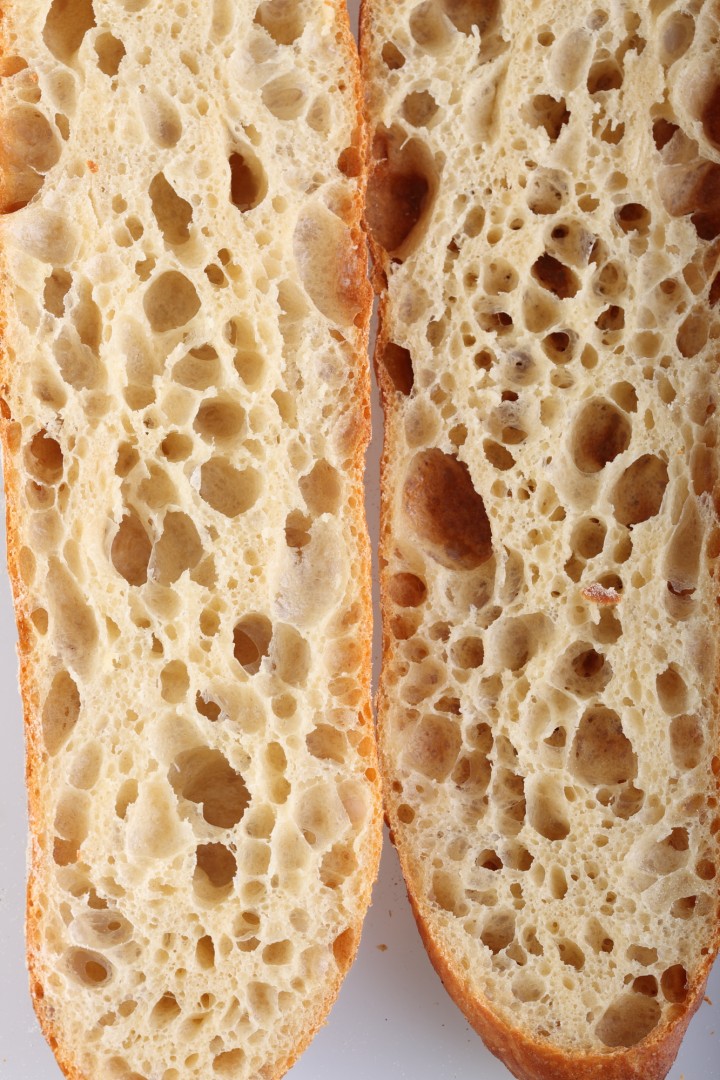
Making the ‘Poolish’
Normally a poolish has equal parts of water and flour, however this time we make a poolish of 80% water which will give you a preferment resembling something between a biga and a poolish. So it is less wet and much less slurry than an actual poolish. In a bowl stir together 380 grams of bread flour with 304 grams of cold water and 3 grams of instant dry yeast. Mix it until you have a consistency that looks like very thick dough-like batter. Cover the bowl and leave for one hour at room temperature. After this hour at room temperature you put the poolish in the fridge for 10 to 17 hours. So if you want to begin your bread making in the morning, you can make your poolish the evening before.
| Ingredients for the Poolish | ||||
|---|---|---|---|---|
| 380 | g | wheat (bread) flour | ||
| 304 | g | water (room temperature) | ||
| 3 | g | instant yeast | ||
| Ingredients for the Baguettes | ||||
|---|---|---|---|---|
| 1 batch makes 4 baguettes (346 g each) | ||||
| the poolish from step 1 | ||||
| 380 | g | wheat (bread) flour | ||
| 304 | g | water | ||
| 12 | g | (sea) salt | ||
| 1.5 | g | instant yeast | ||
Making the Baguettes
The times given in this recipe work best if your room temperature is between 19ºC / 66ºF and 23ºC / 73ºF. If your room is colder, use room temperature water instead of cold water (straight from tap) in the final dough.
Please note: There is no real mixing or kneading in this recipe. It’s all stretch and fold!
Now on with the final baguette dough making: Take the poolish directly from the fridge and first add the 304 g of water to dilute it. Then add the other ingredients (flour, salt and yeast) and combine until you have a shaggy mass. Cover and leave to rest for 10 minutes. Now turn out the mass onto your working surface and stretch and fold for 2 minutes. Keep on at it because it doesn’t look like it’s going anywhere but it will be OK. Put the dough in a greased bowl, cover and leave to rest for 45 minutes.
Stretch and fold a second time, doing two sets ( letter fold: right over left, left over right, bottom over top, top over bottom, repeat)
But back in your bowl, cover and again leave for 45 minutes.
Repeat the above stage another 3 times, but now each time doing only one set of stretch and fold.
Every stretch and fold is followed by a 45 minutes rest in a covered bowl except for the last one. After the last stretch and fold you leave the dough covered with some clingfilm (now looking nice and plump) on your bench for only a 10 minute rest (bench rest).
Preheat your oven to 240ºC / 465ºF (at what stage you preheat your oven depends on how long it takes for your oven to heat through, some take 30 minutes, some, like ours, with stone floors take a lot longer, up to two hours.)
Now divide the dough into 4 equal parts. You are going to pre-shape the dough parts one by one by carefully stretching the corners making a rectangle of each of the 4 pieces and rolling them up. Try to make your rectangle and roll as even as possible without fussing too much with the dough. Use enough flour to handle the dough, but try to keep it to a minimum because you don’t want too much extra flour in the carefully build up 80% hydration dough. Cover and leave to rest for 15 minutes.
Take a roll of dough (which has flattened a little bit during the bench rest) and gently shape it into a baguette shape. My way of shaping this high hydration dough is to sprinkle it with a little flour and press it softly down into a rectangle with a short and a long side. The more even the rectangle the nicer the baguette will look in the end. With a plastic dough scraper you flip 1/3 of the long side onto itself and tuck it in to get some tension on the outside of the dough, now repeat it two more times until you have a roll shape. Make a rolling motion with your cupped hands from the center to the side with a soft touch to make the baguette a bit longer and to make nice pointy ends on both sides of the baguette. Practice makes perfect, do not be hard on yourself, it is not an easy job with a dough as sticky as this.
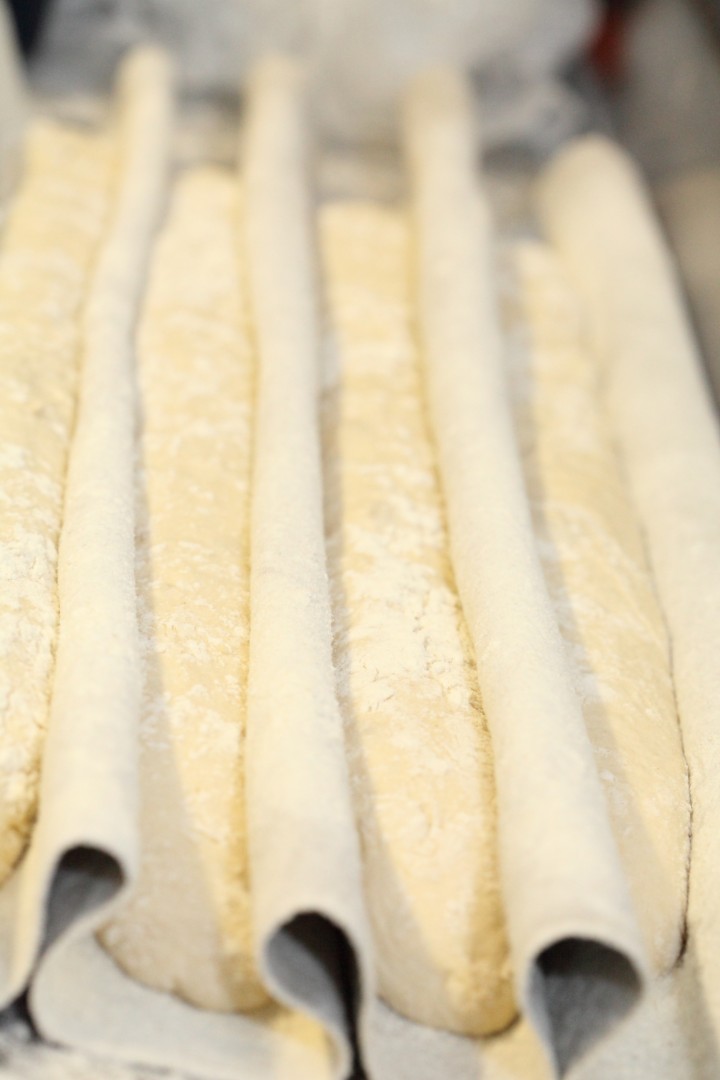 Place the baguettes in a couche made of proofing linen or in a baguette pan, or something of your own invention, but make sure the baguettes have enough side support to hold their shape. Cover them and leave to proof for 25 minutes.
Place the baguettes in a couche made of proofing linen or in a baguette pan, or something of your own invention, but make sure the baguettes have enough side support to hold their shape. Cover them and leave to proof for 25 minutes.
To check if the baguettes are ready, dip your finger in some flour and gently poke in your dough.
If the hole disappears completely: under-proofed
If the hole dent pops half way back out: proofing is just right
If the hole stays entirely dented in: over-proofed
Score the top of the baguettes with a lame/bread scoring tool. Cut as straight along the long axis of the loaf as possible. Mentally divide the baguette into lengthwise thirds, and keep the cuts within the middle third. You can practice the scoring on a piece of paper or a kitchen paper roll first. Overlap the cuts by about one third of their length,while holding the knife at a 30 degree angle. Also check out this very useful video on proper baguette scoring.
Bake in the preheated oven for 25 minutes. Leave to cool on a wire rack.
To get a nice crust, try to create some steam in your oven by putting a small metal baking tray on your oven floor when you preheat the oven and pouring a half cup of hot water immediately after putting the bread in the oven. Release some steam by setting your oven door ajar (perhaps with the help of a wooden spoon or oven mitt) 5 minutes before the bread is ready. If you are going to create steam with a baking tray, you maybe also want to turn your oven temperature a bit higher, because you are going to lose some heat in the process.
Baguette Time Table
Day 1
Make ‘poolish’
Day 2
Mix ingredients until shaggy mass
00:00- 10 minutes rest
00:10 – 2 minutes stretch and fold
45 minute rest
00:57 – 2 letter folds
45 minute rest
01:42 – 1 letter fold
45 minute rest
02:27 – 1 letter fold
45 minute rest
03:12 – 1 letter fold + bench rest
03:22 – divide + pre-shape
03:37 – shape + proof
04:02 – into the oven
04:27 – take out and leave to cool
PS: If you are interested in linen couches / proofing cloths like we use ourselves, you can find them in our WKB webshop.










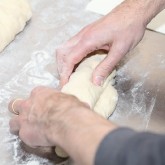






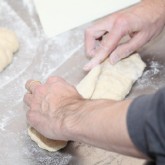
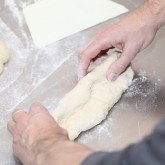
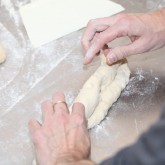


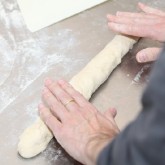
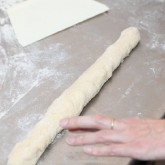








Norman Kellershon says
Long time cook, just beginning baker.
Love your site.
Thanks so much.
Huntington, New York
Weekend Bakers says
Hi there Norman,
Thank you very much. Hope you will give some of our recipes a try. Our bread baking tips section could also come in handy.
Happy baking!
Marieke
martz says
Hi
I just looks amazing !, great job.
Im just been for short time trying to make baguettes like yours but no luck so far. It curious everybody has different ways of making baguette, for example you strech and fold the dought 4 times & leave it resting for 45 minutes each, but this guy in here www.youtube.com/watch…foLju_YK_M just uses a mixer machine and thats all, and the results looks pretty the same, dont they ?.
By the way Im from Europe, over here we mostly use fresh yeast like all Masters instead of instant one, do you know what would be the equivalent ?.
On the other hand I dont have proofen linen, is it very important to get it done right ?.
Also which flour do you use ?, I have seen everybody talks about french T65, but it costs too much over here.
All best
Martz
homepage says
“Recipe for 80% Hydration Baguette | Weekend
Bakery” seriously got me addicted with ur site!
I personallydefinitely will wind up being returning even more often.
Thank you -Samuel
Alamar says
This is such a wonderful post/ forum! The video was very helpful as well. I tried your ” stretch and fold” method and enjoyed its simplistic! I have problems with pre-shaping the dough as mine was still very sticky to handle. I also got too much air and I think I didn’t deflate the dough enough so when trying to pre-shape and final shaping the baguette, it was a challenge! I think this also lead to having difficulty with scoring; as soon as I finish scoring the baguette, the whole unbaked loaf flattened/ deflated so by the time it went to the oven, it was a really sad looking loaf! I didn’t have any “ear” develope so was very disappointed. I’ll have to try again, but if you have any insights on the above, I’d love to hear from you!
Thanks again for this wonderful post!
Weekend Bakers says
Hello Alamar,
We think either you over-proofed your dough or you did not build up enough gluten strength. This last point can either mean your flour is not strong enough (protein content to low) or your stretch and folds need some more attention.
Don’t give up and keep practicing. We did a lot of test runs to get to this point. Also see our baguette log: www.weekendbakery.com/posts…akers-log/ and tips on mixing, flour and dough temp. www.weekendbakery.com/posts…king-tips/
Hope this helps.
Happy baking!
Ed & Marieke
Alamar says
Thanks, Ed & Marieke, for your feedback!!! I’m much appreciated it!
I’m not trying to hog up your time, but I’d like to let you know where I’ve noticed the differences on my experience vs. yours. Truly, I’m not making a comparison, but maybe this was why I couldn’t get to the results that I wanted.
First, after adding flour, water, salt to the “poolish”, I noticed my dough is twice as much as what yours looked like on the video. I used an electric scale every time, and all 3 times, it all came out the same. Your instruction said to divide the dough in 4, but I could divide mine into 6 and make a decent size French baguette.
Second, the third time making this baguette’s recipe, I added 2 more minutes to my initial stretch and fold. Your instruction said to do this only 2 minutes, but I thought for my dough, that wasn’t enough to build the gluten, so I added 2 more minutes. The second and third times, I also added an extra stretch and fold, then the 4th and 5th time, I did exactly what you instructed, only one set of stretching and folding. All 3 times that I’ve made this recipe, my dough Always looked so plum, huge, and LOTS of air/ gas developed, Thus, by the time I reached the pre-shaping, it still contained lots of air/ gas. My pre-shaped load definitely didn’t look so easy to handle! I don’t mind the stickiness of the dough as I used some oil to help, but to me, the real challenge during the pre-shaping and onto the final shaping, is how much air/ gas got trapped in the dough that it was impossible to shape the dough into a rough loaf. By the time the proofing was done, my loaves all looked more like a big mess of jelly dough!!! This is the real difference, and this is what I think was my challenge. Watching your instruction, I see that by the 2nd stretch and fold, yours had already started to look like it was a manageable dough, but mine was still so big and plump it was difficult to handle!
I tried to create steam in my oven, using the baking tray and add hot water to it as soon as the loaves loaded into the oven, but ears were no where to be seen! I baked my loaves on a pizza stone, in the middle of the oven, then beneath the stone, is a big baking tray that I added about 2 cups of water. I also sprayed the oven’s wall and increased the oven’s temperature to almost 550F, and lowered the oven’s temperature to 475F to finish baking.
I have to say I love the yeast, salt/ flour/ water ratio as it does produce such a nice traditional French baguette, but I also want to admit, after my third trials of making this recipe, I feel quite exhausted!!! I would like to practice making it at least twice a week, but the time it takes to stretch and fold, then to rest in between isn’t something I like really! I started the “poolish” the night before, carefully planned out the time, then have a day off from work to bake, and it really took me a whole day to bake these baguettes!!! I don’t want to say that I’m giving it up, but I wish I could have you both watch me handle my dough, shape my dough, score my dough, prepare my oven, etc. then maybe you could tell me how/ what really is my problem!!!
I asked my husband to order a bread scoring tool from your shop so I’m looking forward to getting it! The bread lame I got was from a local restaurant supply around here. It’s a Matfer lame and it’s horrible!! It isn’t sharp, but it has to do for now, until I can order the double edge razor blades somewhere – no one sells the double edge razor blade around here anymore!
Anyway, I’ll work on my stretch and fold technique, but from watching your video, you handle it so delicately and gently that I didn’t think much of it and I thought I was doing the same thing!!!
Thanks again for reading this long response! I just need to get some “steam” out! : )
Weekend Bakers says
Haha, yes, that’s the way to do it. Writing things down is important when improving your baking anyway but it is also a great way to ‘ventilate’ stuff. The only thing we can add after reading your piece is to try and use some different brands of flour and see how that goes. Maybe also play with the amount of yeast you add and/or the resting times given in the recipe.
Hope it will be perfect and manageable soon.
Lots of loaves and thank you for wanting to give our lame a try. Hope you like it too 🙂
Greetings,
Ed & Marieke
Alamar says
Got your bread lame today!!! I was overly excited about it! It is such a beautiful tool and thanks for including the double edge razor as well! I CAN’T wait to have a day off and try baking the baguette with the new tool! If I may, the only thing I’d love to see is for the wooden handle to be slightly slimmer, but it’s only because I have small hands, and you should think about etching “weekend bakery” somewhere on the wooden handle! I’m so glad I finally found a lame I could “cherish”!
Weekend Bakers says
Hello Alamar,
Thank you so much for the feedback and hope it will still work out OK with hands and handle. We will keep your suggestions in mind and will always try and improve whenever possible.
Let us know how the scoring goes!
Happy scoring and baking,
Ed & Marieke
Benoit says
Hi Ed and Marieke,
Thank you so much for this website that is a real goldmine for all bread lovers! Thanks to you I found the best baguette recipe I’ve tried. Weeks after weeks I really enjoy doing this recipe and improve my shaping, my scoring, my baking.
I only got one minor problem, When my baguettes are baked they look really nice with a nice brown crust that seems to be really crusty but when the baguettes cool down they get soft. I tried different way, let them cool on the couter or let them cool on the oven with the door open… but non of these technics keep their crusty crust! Have you any idea about that ?
Thanks you again,
benoit
Benoit says
Any idea?
thanks!
Weekend Bakers says
Hello Benoit,
Two things:
-The first is to make sure your baguettes are properly baked. If there’s still too much moisture in the bread it will travel to the surface and make the crust soft. A guideline to check if your high hydration loaf is done baking is to measure the core temperature with a digital probe thermometer. For wet dough, like this baguette, the core bread baking temperature should be around 96C/ 205F.
-Secondly if your surroundings are very humid this could also have an impact on the crust of the bread.
You could return the baguettes to the oven (preheated at 175C / 350F) for 5 minutes before you want to eat them.
Just to make sure,weI presume you know that you should always let bread cool on a rack so moisture can escape from the bottom too, otherwise your crust will get soft very quickly.
Hope this helps,
Ed & Marieke
Benoit says
Thanks you very much!
I’ll try what your suggestions.
Have a nice day.
Benoit.
Michael Bazant says
Hello,
May I make a small suggestion for the recipe above? In the video you add the second 304 g of water to the poolish to dilute it, then add the rest of the ingredients. The recipe above omits this step, so I added the second batch of flour and water to it at the same time. The result was a very heterogeneous recipe, with a lot of dry and wet patches. An extensive knead would normally address this, but since all you do is fold and fold, there’s less opportunity for the wet and dry to become better mixed.
The result was still very tasty, and the dough had far more holes in it than the other baguette recipes I have tried over the past month. Unfortunately I had to make “Zeus bread” with one loaf, a straight stick wouldn’t work so I had to bend it into a lightning bolt instead.
Michael Bazant says
Sorry, me again. I also have a question about the flour. A true French baguette is supposed to be made with a 55 flour, which I understand is a low-protein flour – though I don’t know the exact protein content. I have all-purpose flour which is 10% protein (3g per 30g of flour) and bread flour which is 13.3% protein (4g per 30g of flour). Which would be better to use? Should I look for a specific protein content? I think the flour I get is a hard wheat flour, which means even the “all purpose” flour might be higher protein than most countries, and approaching most other countries “bread” flour. Thanks!
Weekend Bakers says
Hi again Michael,
We make baguettes with wheat /bread flour that has a protein content of somewhere between 12 and 13% (depending on the batch) and it works very well for us. We also baked with Type 55 (11%) which works fine too, but the taste of this flour is less intense and interesting (at least the one we used). So you could use bread flour with a percentage of all purpose for example. You should just try a few different things and compare the results. It’s the only way to know for sure, with the flour but also all the other factors involved (climate, equipment etc.)
Have you seen our little piece on flour types? Might come in handy: www.weekendbakery.com/posts…our-types/
Happy baking,
Ed & Marieke
Weekend Bakers says
Hello Michael,
Thank you very much for your excellent feed back. You are very right to point out that we should add this information to the written recipe. We will do so.
Glad you liked the recipe and the taste of the bread. The on the fly invention of the Zeus bread sounds pretty cool too 🙂
Happy Baking,
Ed & Marieke
Michael Bazant says
I wish I had seen your breakdown of flour types before, I’ve been wondering exactly what 55 flour was.
I have two further questions:
1) I don’t have a steam injector for my oven, so I have tried a variety of ways of increasing the moisture content (mostly throwing water in at various points during the bake :)). My latest thought is to add water every 3 minutes or so, but bake at a higher temperature (500C). I’m hoping the two would balance each other out – the water cools the oven, but the high temperature keeps the water vaporized. Any thoughts?
2) I have used an egg wash (egg white whisked with water, then brushed on the baguette immediately before baking) in the past. It seemed to help with browning and give the crust a nice chew. Any thoughts on this?
I will be making my 7th (or 8th?) attempt at baguettes this weekend, second try with this recipe. I’ll drop off a comment to let you know how it turned out. Since I keep running out of room on my (round) pizza stone, the Zeus bread will have to become rainbow bread, otherwise it becomes “sad bread” because the ends keep drooping off of the edge. Dank u!
Michael Bazant says
Sorry, 500F, not C, and before you refer me there, I’m just reading your “making the most of your oven” page now!
Weekend Bakers says
Hi Michael,
We would not recommend your method of adding water every three minutes. For several reasons. Water / steam needs to be added at the beginning of the baking process to allow the bread to grow / spring but later on you need to get rid of the moisture for the bread to be able to bake properly and get a cooked crumb and crispy crust. We would suggest to stick to the recipe as close as possible with the help of the oven tips.
We would not think it necessary or recommendable to brush the crust with egg white , the color and chew can be achieved without it. But it also depends how close you want to stick to tradition of course. We would not want to get in the way of some experimenting because good things can come from it too of course.
Good luck with it!
Ed & Marieke
maggie says
Hi my name Maggie I am trying to use your recipe for baguettes 80% hydration but my scales are not working. Can you give me ingredient quantities by volume instead of weight? Either millilitres or cups/spoons would be great. Thank you.
Weekend Bakers says
Hello Maggie,
Yes, I converted it for you as follows:
Ingredients for the Poolish
3 cups bread flour
304 ml water
1 teaspoon instant yeast
Ingredients for the final dough
The poolish
3 cups bread flour
304 ml water
2 teaspoons salt
1/2 teaspoon instant yeast
You can also check out our baking conversion page for some more conversions if needed for other recipes:
www.weekendbakery.com/cooki…nversions/
These converted amounts will not be as accurate as the version done with a scale but I hope it will work out fine anyway.
The video can also help you in showing how the dough is supposed to look and feel.
Happy Baking!
Marieke
Geert says
Just tried this recipe too, using all parameters provided 🙂
Unfortunately, after all the waits and folds, the dough is still very liquid and shapeless.
I feel it’s increasing strength, but it doesn’t keep a shape.
Less water I suppose?
Would this mean that using this flour, it’s technically impossible to create a 80% hydration dough?
How to best “correct” such a dough?
Just wait and fold some extra 45mins?
Thanks
Weekend Bakers says
Hi Geert,
Starting with less water (try this 75% version maybe: www.weekendbakery.com/posts…te-recipe/) would be a good idea and build from there. But flour could be the source of the problem. Do you know the protein content of the flour you use?
Ed
Nathalie says
Hi Ed and Marieke,
Thanks a lot for your replay, I couldn’t bake on Friday, but everything changed this weekend (sometimes that happens…). So I couldn’t bake at all!
Now I’m gonna try it, as a test, if it’s still as delicious as before after staying in the fridge since Friday evening!
If necessary I will ad some extra flour.
The poolish still smells good, lots of bubbles, but the volume isn’t that much as it was.
Keep you posted!
Groetjes Nathalie
Nathalie says
It worked!!! The baguettes turned out great!
I only added 30 gram extra flour, the structure of the dough was a bit ‘softer’ so I did a little extra stretch and fold.
So now we’re eating the bread with home made rocket pesto and mini pizza’s.
Have a nice evening!
Nathalie
Weekend Bakers says
Hi Nathalie,
Very good to hear it still worked after this longer period of time, but it also sounds like you did exactly the right amount of tweaking (added flour some extra S&F) to get it just right. And rocket pesto and pizza…what’s not to like!
Marieke
Nathalie says
Help needed….
Hi Marieke & Ed,
I really, really love this baguette! It’s easy, tasty and we love bread with a crunchy crumb and big holes inside!
Just good olive oil for dipping, some French and Italian cheese and wine, our weekly Friday evening!
But now to the ‘help’ part…. I made the poolish yesterday at 23.00 hours, but unfortunately I cannot make my bread today.
And I don’t wanna throw it away! Can I make my baguettes tomorrow??? And what do I have to change? Less yeast or resting time?
Groetjes Nathalie
Weekend Bakers says
Hi Nathalie,
You can just leave the poolish in the fridge and make your baguettes tomorrow. You do not have to change anything, it should still be fine. If necessary you can add some extra flour to compensate for the little bit more weakened structure of the poolish. The longer you wait, the more the structure in the poolish will be weakened, but one more day will very likely not be a problem.
Groetjes & Happy Baking
Ed & Marieke
John says
What a wonderful web site!…Thank you for all the time that you have put into such an inspirational resource.
Only one question…When are you going to write a book? The quality of the information here and your writing style are much better than many existing, successful, already published books.
Have a great weekend
John
Adrian says
Dear Ed and Marieke
I’m sorry to be a pain again. I just tried this recipe today and somehow my dough was super sticky and could hardly hold its shape when I finished the last turn. It was certainly very stretchy but just floppy somehow. I’m not sure if this was due to over-proofing. My dough did sort of double in volume when I rested it for 45 minutes in between the folds. The crumbs did not have any distinct holes like what you’ve got in your picture but there are lots of mini holes interspersed throughout. I could send you a picture if that helps.
The thing that worried me the most was the fact that my dough never became as smooth as the one shown in your video and it remained really sticky throughout. I could only get hold of the generic supermarket bread flour in the UK and it contains 13+% protein. Also the scoring was near impossible perhaps partly due to my blunt knife (I didn’t have a razor blade nor scalpel) and the knife was literally dragging along the surface bringing the dough with it.
Looking on the bright side the bread still tasted great with a bit of butter and I’ll have a baguette sandwich with brie and Italian ham for dinner tonight. Can’t wait!
Weekend Bakers says
Hi Adrian,
First advice: buy flour from a mill, go back to 70% water to get a feel for the recipe and easier handling of the dough, get a hold of a sharp scoring tool, breath in and out and give it a few more tries. Practice makes perfect and like you said, in the mean time, you are still eating very tasty bread :)).
Off to celebrate old and new as we say over here.
Have a great evening and good start of the New Year!!!
Ed & Marieke
Adrian says
Happy belated New Year to both of you Ed and Marieke! I tried making the 80% hydration baguettes again today and it went so well until I was about to shove them into the oven. I realised that the transfer board was too large for my oven so I tried to pull the baguettes into the oven from within. Ended up burning my arm against the 250C heating element and dropped the baguettes on the floor. 🙁 Luckily no one was around me when that happened or else I’d have had to dial 999 because I was absolutely furious at the time. Anyway I’m determined to get it right this weekend so my new poolish is now brewing nicely in the corner of my room. I’ll make sure I don’t use an oversized transfer board this time. Lesson learned. The painful way.
Adrian
Weekend Bakers says
Sorry Adrian, a painful experience with the small consolation that it happens to every baker at some point.
Ed made his best looking baguettes only to find out after tasting that he forgot the salt. A friend recently got a very nasty burn from the oven light while in a hurry baking croissants. Baker’s tattoos…
But the good news is we just saw you picked yourself up and baked again and had fantastic results! Congratulations!
Adrian says
Hi Ed and Marieke
I’m going to try this recipe of yours tomorrow. Just wondering if I should leave the dough to rest in my room or leave it in my cold kitchen during the 45 minute rest period? Does the rest period serve solely to allow the gluten to relax or is it intended to get some fermentation going on as well?
Hope to hear from you soon!
Regards
Adrian
Mylinh says
Hello
Thank you for the great video and the recipe. I have the convection oven what temperature should I bake at? Do I use 465 F. Thank you.
Weekend Bakers says
Hello Mylinh,
Thank you very much! I would set the temperature at 440F and keep the baking time about the same as mentioned in the recipe (25 minutes). I can also recommend reading our tips about making the most of your oven for bread baking: www.weekendbakery.com/posts…your-oven/
Good luck with the baking!
Marieke
Thomas Gourley says
Hello,
Thank you for this recipe and video, the tutorial is so thorough I enjoyed it very much and is certainly the best I have so far found online.
I have a white/rye sourdough starter that’s around 6 months old. I substituted the poolish yeast with 30g of the starter, as you previously suggested to another poster, and left the poolish at room temp (18c in Yorkshire, UK) for an hour before I went ahead and followed your recipe. I simply couldn’t wait a day for a poolish, so I chanced it!
I should mention that I don’t have much in the way of equipment, so I improvised my way through (scraper = plastic chopping board, etc) and that I’m only a novice baker, so I may well have made mistakes along the way that hindered the outcome.
Also, I may have missed it, but I didn’t see how hot to set the oven, so it went on full blast (250c) as I would with any other bread.
The results were very… interesting, but edible nonetheless! There wasn’t a great deal of rise, and the crumb had the density associated with SD, though very little of the sour note. There was also nothing like the coverage of large bubbles in the crumb I was hoping for. The odd one or two aside, it was filled with little bubbles.
All in all, I wasn’t convinced with the SD, so I would recommend to anyone thinking of using one to think again. Just make a long, thin pain de campagne instead!
Many thanks again, I’ll do the recipe with the poolish from now on.
Weekend Bakers says
Hello Thomas,
Thanks for your comment and sharing your baking experiences with us. The recipe says the temp should be 240C. More important, replacing yeast with sourdough is something you can do, but you would have to adjust the recipe and allow for more time to give the dough the chance to develop properly. You cannot just replace and stick to this recipe without the result at least being different and probably not so good I am afraid. It is no problem wanting to change a recipe, but in order to know what you are doing and where you are coming from, we would suggest (unless you have a problem with using yeast of course) to at least once make the recipe as it is presented to you. The recipe is the result of many baking sessions and you must not give up after making something once, but just practice and stick with it for a while. At least that is the way we both learn a lot. On the other hand, it is great, even though you maybe strayed a bit and your oven may have been too hot, you got an acceptable piece of bread out of it, that you could enjoy anyway, so that is good and something to build on. Way more satisfying than buying we guess and hope.
Hope you will keep on baking and let us know about your other results!
Ed & Marieke
Joachim Willer Holm says
Hi,
What an amazing bread! The first time i made it, i was terrified, honestly. I had never worked with such a wet dough, and throughout the whole process, i kept thinking that it would be just about the worst bread i had ever made, because the S&F’s was close to being impossible for me. But when it got out of the oven… Oh my god. I would say it is the best bread i have ever baked.
But, during the process, i came up with a new technique for doing the S&F, and i would like to hear your opinion about it. Instead of doing the S&F on a table (i only have a wooden table, which is kind of hard to work with a very wet dough at), i would just let the dough stay in the bowl, and then do the S&F in the bowl, which makes it a lot easier. But, by doing this I am also afraid that i would prevent the dough from getting all the air inside of it. What do you think?
Best regards, Joachim.
Weekend Bakers says
Hi Joachim,
Great to hear it turned out so well, that is amazing when making a recipe for the first time. And your technique is perfectly OK. In fact bakers do this all the time, otherwise they would have to lift large quantities of dough, which is heavy work, it is much easier to leave it in the box. The reason we did not do that is of course that our piece of dough is not that heavy and we have a good worktop and it also (in the clip) gives a better view on the S&F itself.
So, just keep doing what you do because it is clearly working!
Have a great Sunday,
Ed & Marieke
Jim says
I made this bread for the first time today. Thanks so much for the extraordinarily thorough and helpful instructions, photographs, and video. The time table at the end is surprisingly helpful in keeping up with where you are in the process. I never could have done it without all that help – I wouldn’t even have tried – but WITH that help it went a lot more smoothly than I expected it to. You do that better than anybody else in the world, as far as I know (better than Jeffrey Hamelman, anyway – I can’t get anything at all from his videos; he seems to assume only professional bakers watch them, and he does stuff too fast with too little description of what he’s doing).
I followed your instructions EXACTLY, like a good robot, even setting the temperature in my kitchen to match yours. The only time I ran into a problem was in pre-shaping the dough rolls and then forming them into baguettes. I couldn’t get the dough to roll up as nicely as you do – one third, then two more, with the dough doing exactly what you tell it to do – but the bread turned out okay anyway. Even the scoring went okay.
The bread looks great, but the taste surprised me. It’s sweet. I used exactly the same ingredients I’ve been using for the past several months to make King Arthur Flour’s Classic Baguettes recipe (www.kingarthurflour.com/recip…tes-recipe): their bread flour, salt and instant yeast from the supermarket, and my tap water that comes from Lake Ontario. This 80% hydration recipe makes a much better looking baguette than the KAF recipe, so I expected it to taste better too, but it doesn’t: I don’t like the sweetness.
Besides the extra water and the different way the dough is handled, the main difference between the two recipes seems to be the way the poolish is made: the time is roughly the same, and the ingredient ratios are even very close, but theirs stays at room temperature while yours goes in the refrigerator. The hydration of the poolish is close to the same, with a pretty stiff dough-like mass to start with (the KAF recipe adds much less water to the final dough).
The KAF recipe specifies 14 hours for the poolish, but I’ve had consistent results with anything from 12 to 20 hours. For this recipe, I left it in the fridge for a little over 16 hours, within the 10-17 hours you call for but near the top end. I’m wondering if the sweetness developed during that phase, and if maybe cutting the time back to 10 hours would eliminate the sweetness. (The poolish was at 37°F when I took it out this morning, if that tells you anything; you don’t say how cold your fridge is, so the good robot had to make do with what he had.)
I did notice a dramatic difference in the appearance and texture of the poolish, by the way. The KAF poolish is bubbly and stringy but fluid, and it roughly triples in size overnight; the poolish I had today had hardly any bubbles in it, was about the same size it was when I mixed it up last night, and the texture was like rubber, or like a huge wad of chewing gum. I’d never seen anything like it – it really did remind me of documentaries about rubber production in tropical jungles, and thought I’d NEVER get the additional flour and even the water mixed into it. In fact, I didn’t, but the stretching and folding seems to have done it. Is that normal, for the poolish to be so… I don’t know what word to use except rubbery, and that really isn’t much of an exaggeration.
If sweetness is a known characteristic of this recipe, I don’t think I’ll bother trying it again, but if you think I just let the poolish ripen too long (or if my fridge is at the wrong temperature) I’ll give it another try. I made that KAF recipe 32 times before I got it so it’s just about perfect for me, so I figured this was a good time to try something different. I’m not sure I’ll try this recipe that many times, especially if it comes out sweet again the next time, because I really do love the taste of the KAF baguette and can almost make it in my sleep now.
This recipe is really no harder or more time-consuming than the KAF recipe, it’s just a different technique, and I’m sure it’d get to be as easy as the KAF recipe is for me now. If I can end up with a baguette that looks like what this recipe gave me but tastes like what the KAF recipe gives me, I’ll have the best from both sides of the Atlantic, but if I have to choose between a great tasting baguette with tiny holes and a sweet baguette with dramatic holes, I’ll choose tiny holes. I’m making this bread just for myself, and I care a lot more about taste than looks.
Weekend Bakers says
Hello Jim,
Thank you very much for your kind words and elaborate analyses. It makes for very interesting reading.
When we make this recipe ourselves it turns out with a sweet note, but we would not call it overly sweet and it also has a more complex taste than that. We do like the difference in taste between the different breads we make, some with a more sour back note, others more sweet or nutty. But we talked about it together and we think we can understand what you mean and if you give it another try exactly like you did, you might very likely end up with the (too) sweet result again. So it is good you already have a recipe that you made completely your own and very much to your liking. We do have one suggestion for a slight modification and another recipe. We also made this recipe and our alternative baguette recipe (find it here: www.weekendbakery.com/posts…te-recipe/) and added a small scoop of our rye sourdough to the poolish (2 g per baguette) and we also liked this result very much. The baguettes had just that little bit of extra ‘kick’. But we have to add that it was very subtle, eating the baguette with cheese it would be harder to discern of course. With the alternative baguette the poolish does also not go in the fridge, so maybe you could give that one a try (maybe with some sourdough added) and the taste would be more to your liking.
Thank you very much again and wishing you many wonderful baguettes,
Ed & Marieke
Jim says
Ed and Marieke,
Thanks for the fast and very helpful reply. It really is only a slight sweetness, so slight that most people might not even notice it, but for some reason I’m overly sensitive to it. And there are other complex flavors that I can’t describe besides the slight sweetness, but the overall effect just doesn’t appeal to me.
I think I don’t like complex flavors in bread, which may be one reason I don’t like sourdough bread in any form. I like a simple, toasty wheat flavor, and that’s all. I had thought about trying your other baguette recipe, but since its flavor isn’t a lot different from this recipe I guess I’ll stay with the KAF recipe.
I’m going to try your Sticky Cinnamon Buns next. My mouth starts watering every time I look at that picture, and it’ll be nice to try something that takes less than 24 hours to make for a change. I got into baking less than six months ago entirely by accident and actually against my will, but now I love it so much I do it almost every day. The process is so much fun that if the result is good at all that’s just a bonus.
This really is not only an extraordinarily helpful website, but it’s beautiful. The photography, the layout, everything about it is lovely to look at and an unusually pleasant overall experience. I was trying to remember last night how I got here the first time, but I couldn’t remember. I’m very glad I did, though. It’s a real treat in many ways. You two are very gifted and very generous to share your gifts with us.
Thanks for all of it.
Jim
Weekend Bakers says
Thank you Jim, for your very kind words about our website and for your honest and very much appreciated comment. It encourages us even more to keep on sharing our recipes and tips and many other ideas we have (but not always have to time for I must say).
And I guess that’s another thing that makes home baking so rewarding, you can make something completely to your own liking, ‘made to measure’.
Hope the cinnamon buns will be to your liking.
Have a lovely Sunday,
Marieke
Luke says
Goededag!
I have been having trouble making this baguette have enough texture and holes on the inside. I want my baguette to be very porous (like in your pictures and videos), but at the moment I have a bread that feels like it has been squished together, making it extremely dense. Also, I have noticed that the bottoms of my baguettes are extremely tough and “chewy”, thus very hard to cut even with a serrated knife. I assumed the problem for all of this was that I didn’t bake it long enough, as the outside of the baguette is very white (not brown like in your pictures), only a shade tanner than the flour. Should I now proceed to raising my oven heat? or leaving the loaves in longer? Other suggestions would help!
Dank u zeer!!!
Weekend Bakers says
Hello Luke,
Well, a number of things could be going a bit wrong here. First of all we would recommend trying a different brand of flour (high quality organic stone ground bread flour would be best if you can find it).
About your oven: Are you sure the temperature on your dial is the real temperature? See these tips to help you further with this subject: www.weekendbakery.com/posts…your-oven/
Trying to create steam is important for you too.
And last but not least take a closer look at the proofing of your dough. Your words indicate either under-proofing or extreme over-proofing (bread collapsed on itself). See these tips to help you :
www.weekendbakery.com/posts…mperature/
www.weekendbakery.com/posts…e-in-size/
Good luck with the baguette baking!
Ed & Marieke
jim coyle says
YOUR 8O% IS THE BOMB. CANT GO WRONG
I LOVE SLOSHING THAT WET DOUGH AROUND
THE SMELL — THE TASTE. YOUSA!!!!
Weekend Bakers says
Hi Jim,
Thanks, we hear you man! Great word ‘sloshing’…
Happy Baking,
Ed & Marieke
Adrian says
Hi Marieke and Ed
As I mentioned in another post, I’m making baguettes tomorrow for the first time (Poolish is now sitting in the fridge). I am thinking of just using parchment paper in place of the proofing couch for my baguettes, is that advisable? I really don’t have anything else other than tea towels. I might also cut strips from cardboard and slide it in between the parchment paper folds to help it hold its shape better.
Also, what’s the best way to keep the baked baguettes? I doubt I can finish two sticks in a day! 🙂
Weekend Bakers says
Our ‘leftover’ baguettes go into the freezer the same day, or basically within a few hours. Some we cut in half before freezing because we make baguette toasties with them under our big toasty maker / grill thingy. For us it works best to put the bread in the microwave and give it a quick blast on high wattage, it comes out slightly warm and some moisture evaporates but after that it is rather perfect to eat. You can only do this with higher hydration dough that can take loosing some water otherwise your bread would dry out too much. Just try what works for you.
We are of the fresh loaf school, some people say (esp. sourdough) only bread gets better one or two days after baking but we do not agree with this ourselves. And baguettes will never get better just lying around. You can always give it a bit of a kick putting it in a warm oven for 5 minutes.
Last resort is turning stale bread into something else: www.weekendbakery.com/posts…w-it-away/
Stale baguettes make great dumplings believe it or not…
Paul Scholey says
Hi,
Just thought I’d mention that I found your website yesterday, having been searching for better baguette recipes having previously been disappointed with results from recipes in books etc. I have to say this has been a revelation today, I’ve had great fun, made a mess of my kitchen but produced 2 of the most successful baguettes ever! I was amazed how well they’ve come out (ok, the slashes didn’t work brilliantly – must try harder next time) and I’m sure it will get even better with practice.
I can’t wait to try the other recipes from your website now!
Weekend Bakers says
Hello Paul,
We are very delighted with your enthusiasm and great result! And as far for the slashing it is also a matter of practice, practice, practice. Maybe these tips can help you too: www.weekendbakery.com/posts…onfidence/
And may we suggest our ‘pain rustique’ recipe, it is our staple bread we make it every week (doing little variations with spelt and whole wheat and rye) and, judging by the reactions, the recipe seems to be working for many other home bakers: www.weekendbakery.com/posts…-rustique/
Thanks again and happy baking!
Ed & Marieke
Tamanna says
Is there anyway you can make the dough and save half to bake the next day? I just don’t need 4 baguette at a time.
Thank you for the amazing demo in your video.
Tamanna
Weekend Bakers says
Thanks Tamanna,
We would suggest you make half of the recipe or make two baguettes and one (small) loaf with the other half, like we did here: www.weekendbakery.com/posts…e-bb-loaf/
Happy baking and good luck with it,
Marieke & Ed
roberto says
Hello,
In the ingredients for the poolish, is it possible to substitute the instant yeast for levain?
Roberto von
Weekend Bakers says
Hi Roberto,
Yes, if you only switch yeast for sourdough (suggest 30 g) in the ‘poolish’ and use yeast in the final dough the recipe will probably work as described and you still have the added sour back note of the sourdough. We have not done this ourselves with this recipe, but others have with good result so we are told.
Hope it works out great,
Marieke
Christlane says
Hi,
I would like to ask if I can use T65 flour in this recipe? or maybe I will mix T55 and T65? If ever, should I use 50%/50%? Since I live here in France I am confused with the the type of flour you use in all your recipes… :((
Thank you so much!
Weekend Bakers says
Hi Again,
Just answered your question on the flour and the pain rustique recipe.
In addition we like the type 65 / wheat flour also for this baguette recipe because it gives more taste (and it also is a little bit healthier).
Wishing you may happy baking days in France,
Marieke
Benjamin Shields says
Thank you so much for this recipe! It is amazing! I still can improve my baguette-forming technique, but you guys helped me out a lot. I have entered the land of big holes and crunchy crusts!
Thanks,
Benjamin
Weekend Bakers says
Hi Benjamin,
Very pleased to hear it! Once you’ve entered that wonderful place, there is no turning back!
Happy baking!
Marieke & Ed
Chris says
Is it possible to break up the steps in midst of all the folding by refrigerating it at some point overnight and picking back up for the last fold or two the next day? I’m a passionate baker, but its difficult to find this long chunk of time for a bread I’d love to try.
Weekend Bakers says
Hi Chris,
Yes, that is possible but you have to take into consideration that the 4 hours you are busy with the dough it is also warming up, if you put it back in the fridge again it has to warm up again for the final proofing (cool dough will not rise) so in the end you will probably need more time to get the job done. I think for the result it would be better if you could stick to the recipe, but if that is not possible, I suggest you take your brake and finish the following day. I hope the result will be great anyway.
Happy baking,
Marieke
Chris says
Well, I tried it – except I replaced the poolish with a sourdough starter of the same hydration and I adjusted the times a bit because of it. I’ve been baking for about 6 years and this was the most ‘satisfying’ dough to work with. It just really feels like you’re accomplishing something. Very tasty – one of the top 3 lean breads I’ve made. Picture here: a3.sphotos.ak.fbcdn.net/hphot…7943_n.jpg
Weekend Bakers says
Hi Chris,
That is a quick and very satisfying result!
Thanks for showing us the great result in the pic, lovely crumb.
Very good to learn from you that with your alterations you still get that tasty baguette!
Have a great Sunday,
Marieke
Russell Warren says
Hello my European friends!
I have made your baguettes and posted about them on my baking blog:
artisansculture.wordpress.com/2012/…baguettes/
Thanks for the hard work you put into making this recipe. I’m extremely excited to taste them (so is the Bible class I am making them for!).
Russ
Weekend Bakers says
Hello Russell,
Thank you for your kind words. Just now read your post and saw your pictures. How wonderful and very entertaining, especially the bit about the amount of ‘down time’ you get with this recipe. Very recognizable.
Not such a daunting prospect if the bread you are eating the coming period is this great.
Keep up the good baking 🙂
Marieke & Ed